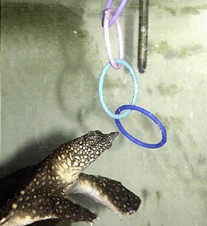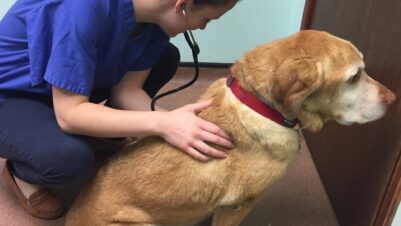IT is estimated that more than 20% of
theUK’sdogpopulationsufferfroma
fear of loud noises, ranging from mild
to severe.
With the ever increasing popularity of
fireworks not just for Bonfire night but
for many other celebrations throughout
the year, this can be a
real problem for owners
and their pets to deal
with.
Dogs may develop
an excessive fear or
phobia towards virtually
any noise but most
commonly they are
directedtowardsbangs
(fireworks, gunshots or crow scarers),
thunderstorms or traffic noise. If left
untreated, affected animals often become
hyper-sensitive and generalise their fear
towards lesser sounds. Soon these dogs
can become reactive to even minor bangs
such as a door or window being closed.
It is well documented that a dog’s
hearing is not only more sensitive than
that of the average human but they are
also able to hear a wider range of sounds,
including both high and low frequency
levels. Fear of loud or unexpected noises
is triggered by the orienting response, the
brain’s mechanism for being aware.
When our dogs hear certain sounds,
the brain instantly processes them to
determine whether they might signal
danger. Often these sounds are dismissed
as “safe” if the dog has experienced them
many times before or if he is able to link
them with a visual stimulus. For example, the first time a puppy
hears a car engine he
may be fearful but after
hearing and seeing cars
on many occasions he
will usually learn to
tolerate them.
Dogs are also likely
to be tolerant of
sounds from a predictable source. The TV often
broadcasts unusual or even disturbing
sounds but for most dogs this is
acceptable: they have learnt to accept the
noises from household audio equipment
and whilst they may not enjoy the
exposure, they are more accepting to this
than random sounds with no predictable
source.
Frequent exposure to sounds,
particularly from a young age, will usually
desensitise the dog to that and similar
noises. However, it is not unusual for
dogs to develop noise phobias in later life
either due to a negative experience or simply through lack of ongoing exposure.
Don’t presume that if a puppy is
accepting of fireworks the first time he
hears them, that he will always be
accepting!
For some dogs, noise phobia is so
extreme it starts to affect their quality of
life and that of their owners; it is not
unusual for dogs to refuse to walk in
particular locations or even leave the
house at all. When left at home alone they
may bark excessively and even become
destructive. Inappropriate soiling in the
house is also often caused by noise
phobias: the pet is simply too fearful to
use the garden for his normal toileting
routine.
These behaviours rarely improve
unaided and are more likely to get
progressively worse. Unfortunately, it is
not unheard of for owners to resort to
euthanasia in extreme situations!
What you can do to help
Treatment of noise phobic dogs is usually
a fairly straightforward procedure but
does require patience and understanding.
It is also a gradual process and is likely to
take some weeks or months. This is not a
procedure to start on 1st November!
- The easiest way of effectively
desensitising a dog is to use one of the widely available CLIX Noise & Sounds
CDs. - Start by playing the CD at a low level
(you may not be able to hear it at all)
whilst the dog is relaxed or engaged in
some enjoyable activity. If the dog reacts
negatively to the CD, you are playing it
too loudly. - Repeat the playing of the CD as
frequently as possible; remember the dog
needs to perceive this noise as completely
normal and commonplace. - Gradually start to increase the volume
as the dog’s tolerance improves. If at any
time he shows a negative reaction, go
back to the previous acceptable level. - Play the CD in as many locations as
possible; different rooms, the car, friend’s
houses or with the use of a portable
system on walks. By putting speakers
outside of the window, it is possible to go
some way towards recreating the effect of
real situations, rather than from a
predictable source. - It may take several weeks or even
months before the dog is completely
tolerant of the CD.
n Consider the quality of the equipment
that you are playing the CD on; the better
the quality of the CD player, the more
realistic and thus more effective the
desensitisation process will be.
The use of classical conditioning can be
extremely effective when
dealing with noise phobic
pets. Rather than using
verbal cues or “commands”
to reach the dog’s conscious
mind, we “associate”
pleasant, happy times
(which for dogs may be
high-value food treats, toys
or simply attention) to
create a positive emotional
response to that particular
situation.
- Whilst using the CD, try to
time the increase in volume
with meal or walk times or
the arrival home of a family
member. - Games can be a great way
to create a positive
association with unusual
sounds; bang a ball against
walls/doors during
playtime; similarly, build
towers from plant pots,
empty drink tins and tea
trays, etc., and crash a ball
into them during games. As the dog’s
tolerance increases, increase the level of
noise.
Give the dog a “safe” place to escape
to if he is feeling worried. A crate is
perfect and draping a blanket over the
crate may help him to feel more secure.
No one should attempt to force the dog
out of his crate; if he chooses to go there,
he should be left alone.
Similarly, allowing the dog access to
an area of the house which is deemed to
be “high value” can be beneficial and
allow him to gain comfort as well as
retreat. Owners’ bedrooms often fit this
category.
Often owners of noise phobic dogs
unwittingly fuel their dog’s nervous
behaviour by comforting or reassuring
him. Dogs are unlikely to understand
reassurance and are more likely to
perceive this as approval of their nervous
behaviour.
Avoid sympathy
Owners need to take on a “jolly hockey
sticks”-type attitude during stressful
situations. Allow your pet to gain comfort
by being with you but without receiving
sympathy.
Likewise, subjecting an obviously
frightened dog to more stimuli is counter-
productive, dogs do not “learn” or
process information well when they are
overly stressed.
As bizarre as this may sound, many
long-eared dogs can be trained to accept
wearing some simple ear plugs to act as a
barrier against some of the noise! The
easiest way is to use one leg of ladies’
tights or stockings with the toe cut out.
This can then be doubled back and forth
over the head to comfortably hold the
ears against the head. This procedure, unfortunately, is not normally acceptable
for dogs with pricked ears.
DAP (dog appeasing pheromone) is
now readily available in diffuser, pump
spray or even collar form. These may help
the dog feel more secure and less anxious
during both training and the whole
firework season. If using a diffuser, plug
it in near the dog’s “safe” place.
Homoeopathic and herbal
remedies, for example “Anxiety”, are
another popular and safe aid in
treating any anxiety-related problem.
Natural ingredients such as
chamomile, valerian and borax have all
been shown to be effective in helping
to maintain calm.
“Anxiety Wraps” are a type of
elasticated jacket that have been
specifically designed to apply pressure to
key points on the dog’s body (similar to
acupuncture) helping to calm distressed
dogs.
TTouch is a unique form of massage
based on circular movements of the
fingers and hands all over the body: the
intentistoactivatethefunctionofcells
and awaken cellular intelligence. As well
as being used for injured animals, TTouch
practitioners often have success with
fearful and phobic pets.
A combination therapy of behaviour
modification and anti-anxiety drugs may
be necessary for extreme cases of noise
phobia. Although some traditionally-used
sedatives are now contra-indicated in the
treatment of noise phobias, there are still
any number of medications available.
Pharmacological therapy will vary
according to the severity of the problem,
the medical history of the patient and the
personal opinions of the prescribing
veterinary surgeon and/or consulting
behaviourist.






